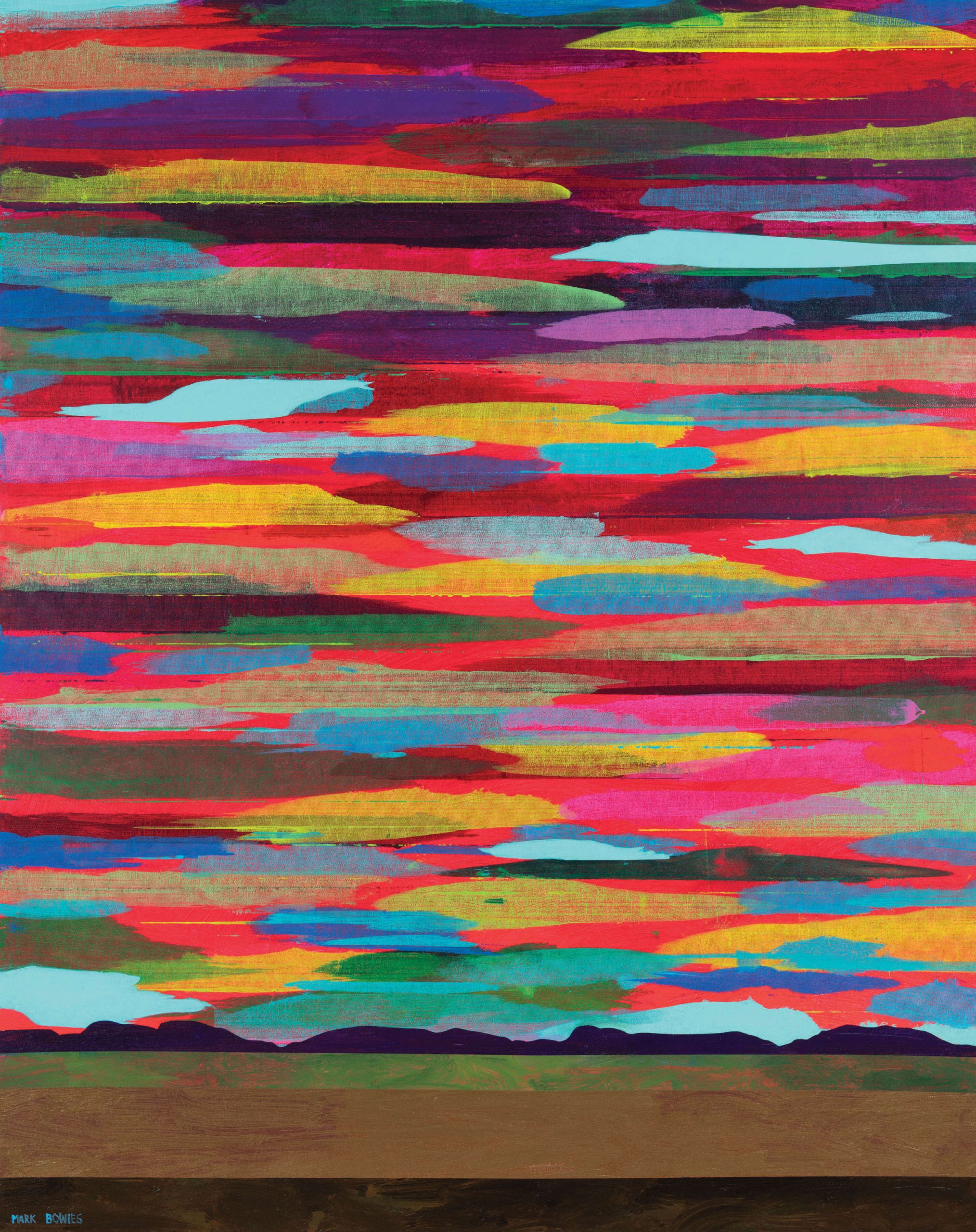
06 Jul Interpretations of a Western Sky
For centuries, artists have grappled with ways of rendering the atmosphere — that ever-changing mix of clouds, light, wind, and sky — and how it affects the world below. Northern California artist Mark Bowles explores this subject for its own sake, painting ethereal environments that morph into powerful abstract and representational statements.
Inspired and partially mentored by his mother and enamored with the arts since childhood, Bowles has been painting full-time since the 1970s. Early influences include works by Paul Gauguin and the Fauvists, affecting his development as a colorist. Formal studies at San Francisco’s California College of the Arts and a stint at San Miguel de Allende’s famed Instituto Allende in Mexico contributed to a growing interest in minimalism that eventually focused on the dynamic colors of the Western sky — an immutable way to connect with his own inner reality.
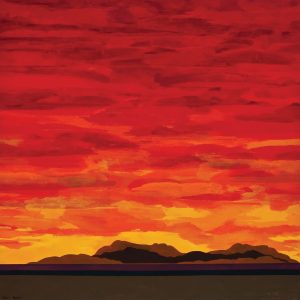
Summer Solstice | Acrylic on Canvas | 48 x 48 inches | 2016
The artist begins with a blank canvas and acrylic paint in his spacious studio near the outskirts of Sacramento. “I like to begin with a horizon line as a way to imply sky and earth references,” he says. “From there, I lay in the background color of the sky.” Avoiding any preconceptions of the result, he prefers to start with a particular size, select the materials, and let the image grow as he layers color.
“Painting makes me feel alive,” Bowles says. “If I’m successful, I can draw the viewer into my space as they become involved in their own personal discovery of the work. That dialogue is the ultimate reward, a way to communicate something new to the viewer, even if just for a brief moment. Titles of a painting follow merely to help the viewer find reference.”
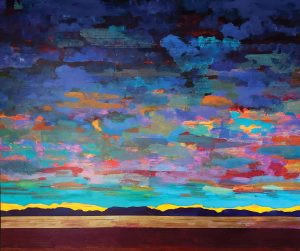
Back Lit Mountains | Acrylic on Canvas | 60 x 72 inches | 2023
The rest appears to be magic as Bowles adjusts and balances line and hue. “In the end,” he summarizes, “it’s all about how I want the sky to be seen — hopefully, in a brand new way.”
Lest anyone thinks Bowles’ paintings are a repetitive series, look again. Each canvas is the resolution of a challenge, proving how color can create a sense of depth, radiate temperature, and suggest three dimensions. They are a symphony of brushstrokes that move from warm to cool and back again, often layered to suggest density or transparency, foreground or distance, and even a sense of weight. Color transmits emotion, and these bold canvases speak. Beyond that is the mystical matter of the message, heard differently by every viewer but heard nonetheless.
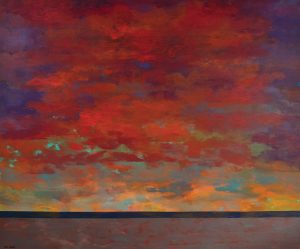
Untethered, Unbound | Acrylic on Canvas | 60 x 72 inches | 2019
“I address the canvas with a huge amount of trust that my inner artist will guide me. My heart pushes my work to find new ways of expressing what I see and how I feel about it,” says Bowles. “In effect, the result is the language of my soul, a reflection of being in the ‘now’ and living in the moment, in my own truth.”
owles’ truth resonates with others. Widely collected, his work is represented by Canyon Road Contemporary Art in Santa Fe, New Mexico; Slate Gray Gallery in Telluride, Colorado; Mark Sublette Medicine Man Gallery in Tucson, Arizona; CODA Gallery in Palm Desert, California; and Chloe Gallery in San Francisco. Six of his paintings reside in the permanent collections of such museums as the Crocker Art Museum in Sacramento and the Denver Art Museum in Colorado.
Bowles maintains a relentless schedule, painting every day, and seeking new interpretations. Comfortably anchored in the contemporary Western art world, Bowles has two 2023 exhibitions: one at the Slate Gray Gallery in August and another at Canyon Road Contemporary Art in September.
“When you look at the work of painter Mark Bowles,” says Melissa Chandon, a former colleague, painter, and art instructor at the University of California, Davis, “you go on a journey, a journey that bears the stamp of no particular time. The work both calms and ignites the senses. For me, I feel I could just as easily be looking out onto the Western sky of the distant past or, perhaps, looking into the future.”
When asked if these paintings represent something metaphorical, Bowles replies that his current works might, in fact, stand for the very process of life itself — an accumulation of learning and painting for more than 50 years. “The evolution of my style
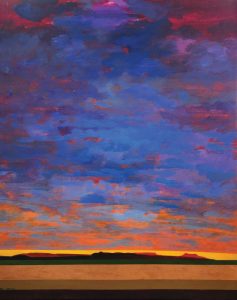
View of Red Mesas | Acrylic on Canvas | 60 x 48 inches | 2023
,” he explains, “has taken various twists and turns, particularly in terms of how I define art. As the subject matter has clarified, so has my confidence grown; more insight, less searching.”
Lest one over-intellectualize Bowles’ process, his work is ultimately about the landscape, seen anew through the layers of the atmosphere. In a series called Summer Heat, for example, the red sky suggests the heat of the day, something Californians know well. According to Bowles, we all have memories of many landscapes, and he strives to awaken those memories, creating a common bond between us in a way that only art can.
Upon closer study of his canvases, questions might arise. At what point is the painting finished? How does the artist know when to stop? Bowles’ answer likens a painting’s completion to a feeling he once had fishing on a creek as a kid. When the sun sparkled off the water as he floated downstream and the entire world seemed at peace, he called that glimmering moment “being on the river,” much like today’s expression of “being in the zone.” That’s how he feels when a painting is done: “on the river.”
Bowles’ work has broad appeal. “A lot of people tell me,” says the artist, “that the landscapes remind them of their childhood growing up in the Midwest … flat horizons and endless views. That said, my clients vary widely. Once, an excited college kid called, [after] having acquired one of my paintings at an auction. Others have been collecting my work for decades. One of my most well-known collectors is John Mayer, who owns two paintings.”
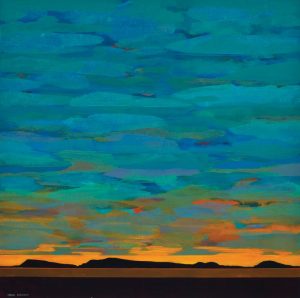
Sunrise | Acrylic on Canvas | 48 x 48 inches | 2018
More than a colorist, Bowles’ proudly defends his sense of regionalism. “I enjoy the abstraction and relationships of color as I paint renditions of the sky, but I’m always pulled back to the West, forever anchored to the clean lines of the landscape, the solitude, wind, and the peacefulness. I don’t ever replicate what I’ve seen, be it the Central Valley of California or the Desert Southwest. I only share my memories of the places I’ve been, my paintings merely a suggestion.”
In the end, great art is measured by its ability to move others. Collector Estelle Saltzman sums it up by saying, “I have several of Mark Bowles’ paintings and am proud to show them off. What draws me most to his work [are] the richness and depth of color created by the layering of paint. Large or small, his art reflects a deep understanding and appreciation of the environment we all share. I love how his paintings convey emotion and a positive view of the future.”






No Comments